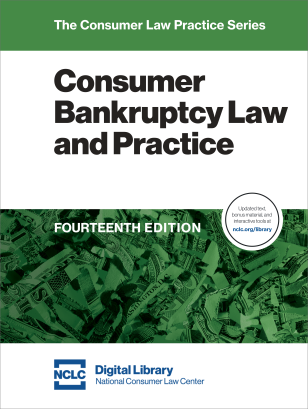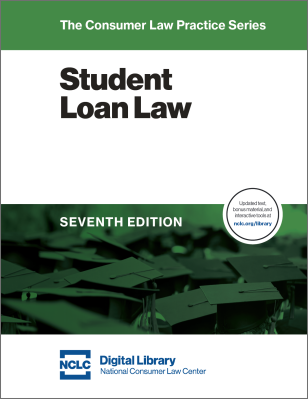New, Free, and Interactive Tool Described
NCLC has just released a free interactive online tool, Corporate Bankruptcy 101 for Consumer Litigators, that aids consumer attorneys representing clients when a business files for bankruptcy. Too often defendants faced with serious individual or class liability exposure file bankruptcy—be they schools, car dealers, creditors, landlords, or other businesses. Even when not being sued, a business’s bankruptcy can adversely affect thousands of a business’s customers—lost deposits, promised services not performed, disruption of a residential lease, confused records, and the like.
An important is example is bankruptcies by predatory schools, such as ITT, Corinthian Colleges, and EDMC, that may compromise the rights of thousands of borrowers to challenge the school’s practices, collect evidence for administrative federal student relief, or raise FTC Holder Rule defenses on private student loans. See NCLC’s Student Loan Law Chapter 13. Similarly, when finance companies and mortgage servicers file bankruptcy, this can complicate the rights of hundreds of thousands of homeowners to raise claims and defenses on their mortgage loan. See NCLC’s Consumer Bankruptcy Law and Practice § 18.9.3a. There may also be increased landlord bankruptcies due to the COVID-19 pandemic, complicating the rights of tenants. See NCLC’s Consumer Bankruptcy Law and Practice § 18.8.
Corporate Bankruptcy 101 for Consumer Litigators is a detailed flow chart explaining for consumer attorneys the steps they can take in a business bankruptcy to vindicate the rights of individual consumers or a class of consumers—rights to recover court awards, recovery for paid services not performed, remedies to address business misconduct, and even changing a reorganized business’s practices. Consumer litigants must also understand the impact of the automatic stay on any consumer litigation against a business, which could even lead to sanctions against the consumer attorney.
Corporate Bankruptcy 101 for Consumer Litigators guides the consumer attorney step-by-step through the corporation’s bankruptcy process, explaining when and what actions the consumer must take to obtain a recovery. Separate flow charts are provided for chapter 7 and chapter 11 business bankruptcies, and each flow chart is accompanied by a glossary of key bankruptcy terms. The tool also includes sample pleadings.
The flow charts detail what a consumer attorney needs to know about:
- The automatic stay and its impact on consumer litigation;
- Undoing a business’s fraudulent asset transfers to avoid creditors;
- Suing a business in bankruptcy court;
- The simple process for consumers to submit claims for payment out of the bankrupt’s assets;
- In a chapter 11 business bankruptcy, creating special consumer committees or victims’ committees;
- In chapter 11 bankruptcies, creating a litigation trust (with sample pleadings) to preserve interests of consumers to engage in litigation against the business;
- How consumer litigants can use the bankruptcy process to review detailed business information that might otherwise be impossible to obtain;
- How consumers can participate in the chapter 11 bankruptcy to change a business’s practices;
- When and whether the consumer will recover in the business bankruptcy.
For Even More Detail
For more detail on these subjects and for a full discussion of consumer rights when a business files a chapter 7 or chapter 11 bankruptcy, see NCLC’s Consumer Bankruptcy Law and Practice Chapter 18. This recently revised, 78-page chapter with extensive citations comprehensively covers:
- Preparing for the business bankruptcy, § 18.2.1;
- Putting the business into involuntary bankruptcy, § 18.2.2;
- The automatic stay and consumer litigants obtaining relief from the stay, § 18.3;
- Individual and class consumer proofs of claim, § 18.4;
- Strategies to increase consumer recoveries, including the consumer priority, claiming business assets are in trust for consumers, post-petition claims as administrative expenses, arguing debts are non-dischargeable, and equitable subordination, § 18.5;
- The consumer proceeding in the business bankruptcy in forma pauperis to waive various bankruptcy fees, § 18.6;
- A complete guide to consumer and employee rights in a business’s chapter 11 bankruptcy, § 18.7;
- Representing tenants when a landlord files for bankruptcy, § 18.8;
- Representing consumers when lenders file for bankruptcy, § 18.9;
- Preservation of consumer claims and defenses when consumer’s obligation is transferred to another, § 18.9.3a;
- Representing consumers when a health care provider files for bankruptcy, § 18.10;
- Protecting consumer privacy rights when a business files for bankruptcy, § 18.10.
NCLC’s Consumer Bankruptcy Law and Practice Appendix G contains nine key sample pleadings where a consumer is a creditor in a business bankruptcy (although several focus on rights of tenants, these pleadings can be adapted for other types of business bankruptcies):
- Motion for Relief from Stay by Tenant to Raise Counterclaims to Eviction;
- In Forma Pauperis Motion, Certification, and Memorandum;
- Complaint to Determine Dischargeability of Tenant’s Claims Against Landlor
- Motion for Appointment of Committee of Tenants;
- Expedited Motion for Appointment of Committee of Consumer Creditors;
- Statement of Attorney Pursuant to Rule 2019;
- Objection to Chapter 11 Disclosure Statement;
- Objection to Confirmation of Chapter 11 Plan;
- Complaint Seeking Subordination of Secured Creditor’s Claims.



